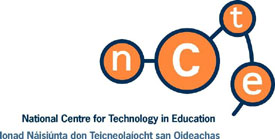| 2003 |

|
YEAR BOOK |
National Centre for Technology in Education
|
Government initiative continues
to raise levels of ICT use in schools
|

|
� professional development of teachers
� developing interactive resources for learning and teaching � advising schools on technology options and applications � the development of ScoilNet as the Irish education portal website � supporting Special Educational Needs throughout all ICT initiatives. |
In addition, the NCTE evaluates progress to date, disseminates findings, and advises on continuing policy and strategy. Three European Projects on Internet Safety have been hosted by the NCTE, culminating in the widely-publicised Be Wise on the Net campaign.
Use of ICT in schools
At the end of 2002, the NCTE conducted its third full national census of ICT in Schools. The focus of the ICT in Schools Initiative continues to be the integration of ICT use in the classroom. It is encouraging then that the use of ICT in primary, post primary and special schools is almost universal. Preliminary results show a marked increase (65%) in the total number of computers in schools, reflecting the improved pupil computer ratio (PCR). In primary schools, the PCR fell from 37 to 12 over four years. Post primary schools had higher levels of equipment initially but their PCR has still dropped from 16 in 1998 to 9 in 2002. Special schools are even better equipped, having a PCR of only 4 in 2002. The majority of all computers in schools are less than four years old. Interestingly, both primary and post primary 'disadvantaged' schools proved to be better equipped than average schools.
Internet access and use in school
Internet connections have improved at post primary level, with 85% using ISDN lines. DSL connections are used by 3.5%, and 1.9% have satellite connection to the Internet. Of post primary schools, 69% have a network, with 86% having Internet access distributed to multiple computers. In primary schools, 75% of classrooms and 84% of special school classrooms are equipped with computers - however, only approximately 30% of these are connected to the Internet.
* This information is compiled from an initial report by Dr. Aidan Mulkeen, Education Department, NUI Maynooth.
Contact: National Centre for Technology in Education, Dublin City University, Glasnevin, Dublin 9; Tel: 01-700 8200; Fax: 01-700 8210; E-mail: [email protected] ; Web: www.ncte.ie and www.scoilnet.ie